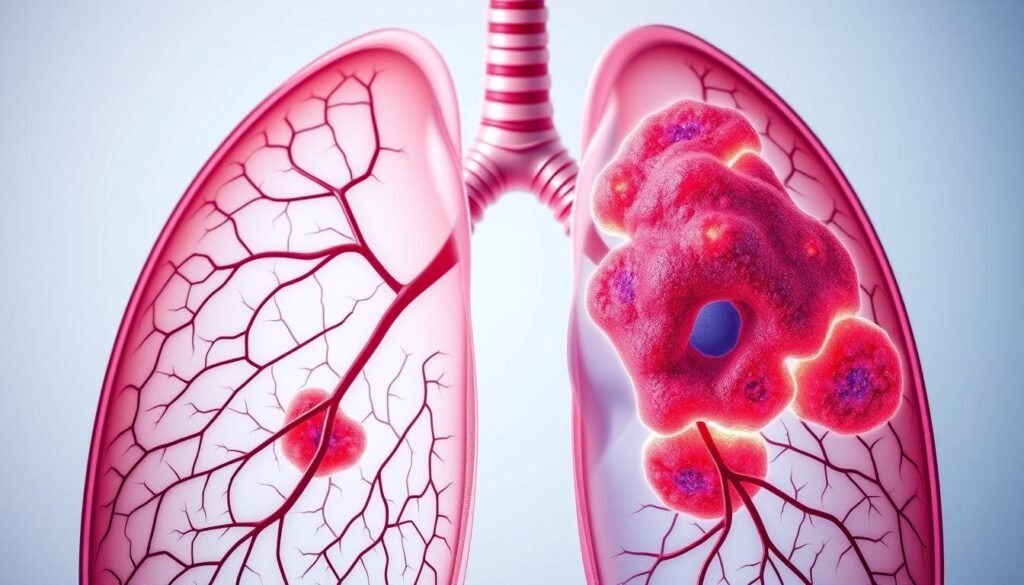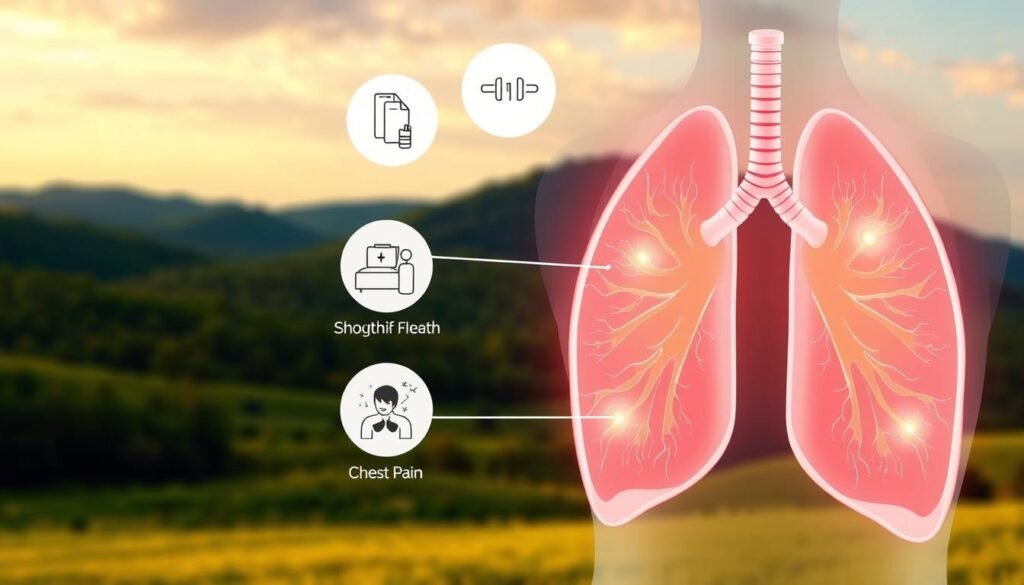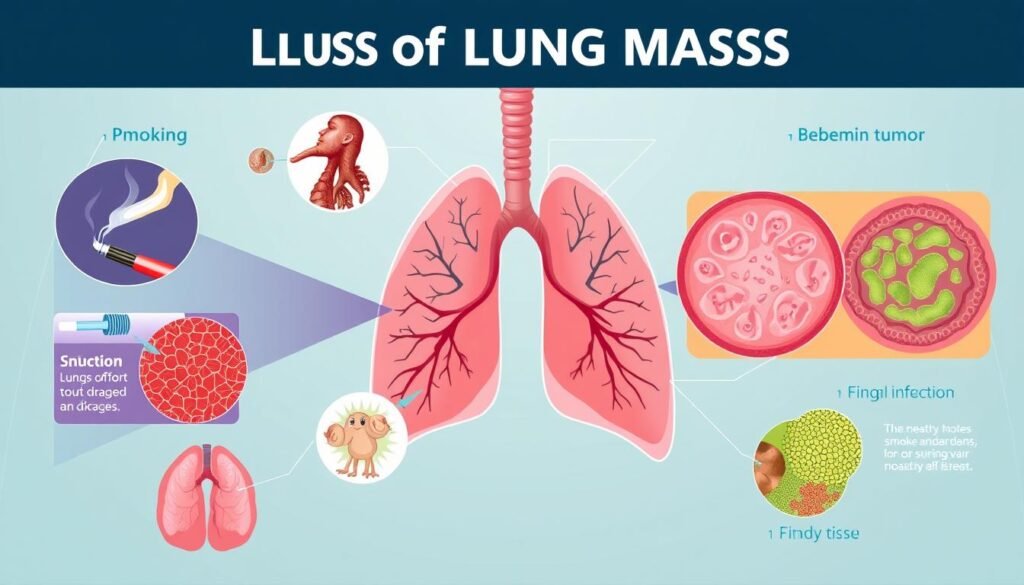Did you know that lung cancer causes about 20% of all cancer deaths in the U.S.? It shows how crucial it is to understand lung masses. They are abnormal growths in the lungs larger than 3 centimeters. Most lung masses are found by accident during imaging tests. It’s key to figure out if they are benign or cancerous.
Misconceptions can make people very anxious. That’s why it’s vital to know the truth about these growths. This includes knowing about lung mass symptoms, what causes them, and how they can be treated. Learning if lung masses are always cancerous is important for lung health.
Key Takeaways
- Lung masses are larger than 3 cm and can either be benign or malignant.
- Early detection of lung mass symptoms can significantly influence treatment outcomes.
- Understanding the causes of lung masses is crucial in risk assessment.
- Most lung masses are found incidentally during imaging tests.
- Statistics indicate a higher likelihood of malignancy with larger nodules.
- Regular screenings can aid in early identification of serious conditions.
Understanding Lung Masses
A lung mass is an area in the lungs that’s bigger than 3 cm across. This makes it different from smaller lung spots called nodules. These masses can be caused by infections, benign (not harmful) tumors, or lung cancer. Knowing the types of lung masses is key for patients and doctors to find the right treatment options.
Lung masses can be benign or malignant. Most lung nodules are found by chance when checking for other health issues. Studies show that up to half of adults getting a chest scan may have a nodule. Yet, about 95% of these nodules are not dangerous. This means they don’t need treatment or hurt your quality of life if they’re small and not cancer.
The outlook for someone with a lung mass can be quite different based on many things. People with small nodules often don’t need any treatment. But, those with nodules 9 mm or bigger usually have more tests, like a biopsy. Finding these early can really help improve the outlook, especially for cancer. Quick treatment can lead to much better results.
For more info on lung mass types, how they are diagnosed, and treatment options, check out this resource.
What Defines a Lung Mass?
A lung mass is an abnormal growth in the lungs larger than 3 cm. Doctors look at its shape, size, and texture during lung mass diagnosis. By studying these, they can guess if it might be cancer.
Tests like X-rays and CT scans are key to spotting lung masses. X-rays find nodules in 1 out of 500 patients. CT scans are even more useful, finding lung nodules in half of all adults.
Not all lung masses mean cancer. Actually, 95% of lung nodules are not cancer. So, are lung masses always cancer? Only 3 to 4 out of 100 are. Most non-cancerous lung masses, such as hamartomas, are not dangerous.

Doctors think about many things when they look at lung masses. This includes the patient’s history and if they’ve been around risks, like smoking. The chances of cancer are higher in smokers, older people, and those with a family history of cancer. These details show why a careful diagnosis is crucial.
Are Lung Masses Always Cancer
Many people worry about lung masses being cancer. Yet, not all lung nodules are malignant. Understanding the facts can ease fears for those unsure about their symptoms.
Statistics on Lung Mass Malignancy
Lung nodules seen on CT scans often aren’t cancer. Whether they are depends on size, shape, and location. Small nodules, less than 5 mm, rarely are cancerous.
Nodules between 5 mm and 10 mm have up to a 28% chance of being malignant. Large masses over 2 cm have a higher cancer risk, between 64% and 82%. Watching them with CT scans is key. For more, read this article.
Benign vs. Malignant Lung Masses
Telling benign from malignant lung masses is important for care choices. Benign ones, like hamartomas, need different treatments than cancer does. Hamartomas are most of benign lung tumors.
They look like round spots on chest X-rays. But cancer needs tougher treatments. Knowing the difference helps doctors plan the right approach.

Common Causes of Lung Masses
Lung masses can come from different factors. Knowing why they happen is key to finding the right treatment. There are factors we can’t change and those we can, affecting our risk of getting a lung mass.
Non-Modifiable Risk Factors
Some risks for lung masses can’t be changed. It’s important to know our own risks. These include:
- Genetics: Family history can make us more likely to get lung masses.
- Age: Getting older, especially over 40, can increase our risk.
- Previous Conditions: Past respiratory issues can make us more vulnerable.
Modifiable Risk Factors
Some choices we make can also affect our risk. Changing these habits can help lower our chances of getting a lung mass:
- Smoking: Smoking is a big cause of lung masses.
- Environmental Exposure: Being around harmful substances can raise our risk.
- Infections: Not treating infections like tuberculosis can lead to lung masses.

Symptoms Associated with Lung Masses
Some people with lung masses don’t feel anything unusual. Others find out they have one during a chest X-ray or scan that’s done for some other reason. But when symptoms appear, they can be serious. Knowing what to watch for helps you seek help soon enough.
Common Symptoms to Look For
Noticing early signs of lung masses is key to getting the right help. Look out for trouble breathing, having a cough that won’t quit, losing weight without trying, feeling pain in your chest, or coughing up blood. These can be signs of something minor. Yet, they might also mean lung cancer. It’s smart to be aware and ask: are lung masses always cancer?
- Shortness of breath
- Chronic coughing
- Unexplained weight loss
- Chest pain
- Coughing up blood
Remember, even if you think it’s nothing, these symptoms could point to something like lung cancer.
When to Seek Medical Attention
If your symptoms don’t go away or get worse, see a doctor. Finding the cause early can make a huge difference in treatment. Lung masses with symptoms like bone pain, yellow skin, or thinking problems are especially urgent. To learn more about spotting lung cancer early, go to this resource.
Diagnosing Lung Masses
Figuring out lung masses is key to knowing if they are harmful or not. Using different imaging methods is very important. They tell us about the mass’s size and details. Finding out early and correctly what the mass is can really change the treatment options.
Imaging Techniques for Detection
Healthcare workers use high-tech imaging to look for lung masses. Each technique has its own benefits:
- Chest X-rays: Usually the first step, they show if there are masses and help decide what to do next.
- CT Scans: They give detailed images of the lungs. This helps find out the size and shape of the mass.
- MRI Scans: These are good for looking at the soft parts around the lungs.
- PET Scans: They check how active the mass is, which might tell if it’s cancer.
If lung nodules are bigger than 8 mm, there’s a higher chance they could be cancer. When nodules look strange or get bigger, a biopsy might be needed. This helps figure out if the mass is harmful.
Role of Biopsies in Diagnosis
Biopsies are very important for confirming what the lung mass is. They let doctors look at the mass closely, under a microscope. This tells them if the mass is safe or not. There are many ways to get a biopsy:
- Needle Biopsies: A small needle pulls out cells from the mass.
- Bronchoscopy: A tube goes into the airway to get tissue from the lungs.
- Endobronchial Ultrasound (EBUS): This is a bronchoscopy with an ultrasound. It checks the lymph nodes.
Sometimes other tests are done to get tissue samples. This includes mediastinoscopy and video-assisted thoracoscopy (VAT). In some cases, surgery is done to take out part of the lung for testing.
Knowing all about the diagnostic process helps patients deal with lung mass worries. Getting the right diagnosis is crucial. It affects what treatment is needed to get better.
Treatment Options for Lung Masses
The treatment for lung masses depends on if they are benign or malignant. Swift action is very important if the masses are malignant. Doctors use imaging results and the patient’s health to choose treatment. Not all lung masses need quick treatment, especially if they don’t harm lung function or are not cancerous.
When Treatment is Necessary
Treatment for lung masses depends on many factors, like the type of mass. It’s urgent to treat:
- The mass is deemed malignant based on diagnostic imaging.
- It causes significant symptoms or obstruction in the airways.
- The mass undergoes changes over time that suggest growth or malignancy.
Doctors consider these factors before choosing a treatment plan. Talking about treatment options is key to finding the best way to help each patient.
Common Treatment Approaches
There are several treatments for malignant lung masses:
- Surgery: Different surgeries can be done based on the mass’s size and place.
- Chemotherapy: This can help get rid of cancer cells after surgery or make tumors smaller before surgery.
- Radiation Therapy: Used for cancers that have spread. It can be used with chemotherapy for better results.
- Targeted Therapy: This focuses on cancer cells’ specific pathways. It’s used when cancer has spread or come back.
- Immunotherapy: Helps the immune system fight cancer. It’s an option after surgery or if surgery isn’t possible.
The outcome and management of lung masses depend on the treatment method. Each option has its own benefits and risks. Doctors will explain these based on what each patient needs.
Prognosis of Lung Masses
The outcome of lung masses depends on various factors. Knowing these can help patients take an active role in their health care talks and choices. Even though many lung nodules are not cancerous, there’s always a chance for cancer. Understanding your risk helps make better choices about tests and treatment.
Factors Influencing Prognosis
Certain things impact the outlook for lung masses:
- Size of the Mass: Smaller masses usually mean a better outcome. For example, very small masses have a high chance of surviving five years.
- Patient’s Overall Health: A patient’s health history and current conditions can change what treatments work and how well they recover.
- Presence of Malignancy: About 40% of lung nodules may be cancerous. Early finding and treatment can improve survival rates.
- Growth Rate: Cancerous nodules might grow quickly, about doubling size in four months. This is faster than non-cancerous ones, which grow slow.
- Diagnosis Timing: Finding the issue early is key for better treatment results. Many see good outcomes with quick action.
Non-cancerous nodules often need little treatment, whereas cancerous ones might need to be taken out. Advances like Ion Robotic-Assisted Bronchoscopy and Endobronchial Ultrasound help doctors tell the difference between benign and malignant masses. This is crucial in predicting the outcome for lung masses.
For more info, you can check pulmonary nodules and lung lesions treatment. Keeping up with doctor visits is important to watch for changes in lung masses, which helps in managing them better.
Types of Lung Masses
Lung masses can be either benign or malignant. Each type has unique features and treatment needs. It’s important to know the difference for effective care. You must get good medical advice if you find a lung mass.
Common Types of Benign Lung Masses
Hamartomas, lung abscesses, and pulmonary artery aneurysms are benign lung masses. Hamartomas are common but usually don’t cause symptoms. They are watched over time instead of treated right away. Lung abscesses come from infections. They can be cleared up with antibiotics.
Knowing about these can ease worries about cancer. Most lung nodules—about 95%—are not cancerous. This info helps eliminate unnecessary fear.
Common Types of Malignant Lung Masses
Malignant lung masses mainly are types of lung cancer. Non-small cell lung cancer (NSCLC) makes up 80% to 85% of these cancers. Adenocarcinoma is a common subtype, especially in smokers and more in women.
Squamous cell carcinoma is linked to smoking too. It usually starts in the central parts of the lungs. Small cell lung cancer (SCLC) spreads quickly and is 10% to 15% of cases. Metastatic cancers spread to the lungs from other body parts. They keep the name of their original location.
Identifying these malignant masses early is key for the best chance of recovery. For early signs of lung cancer, see this resource.